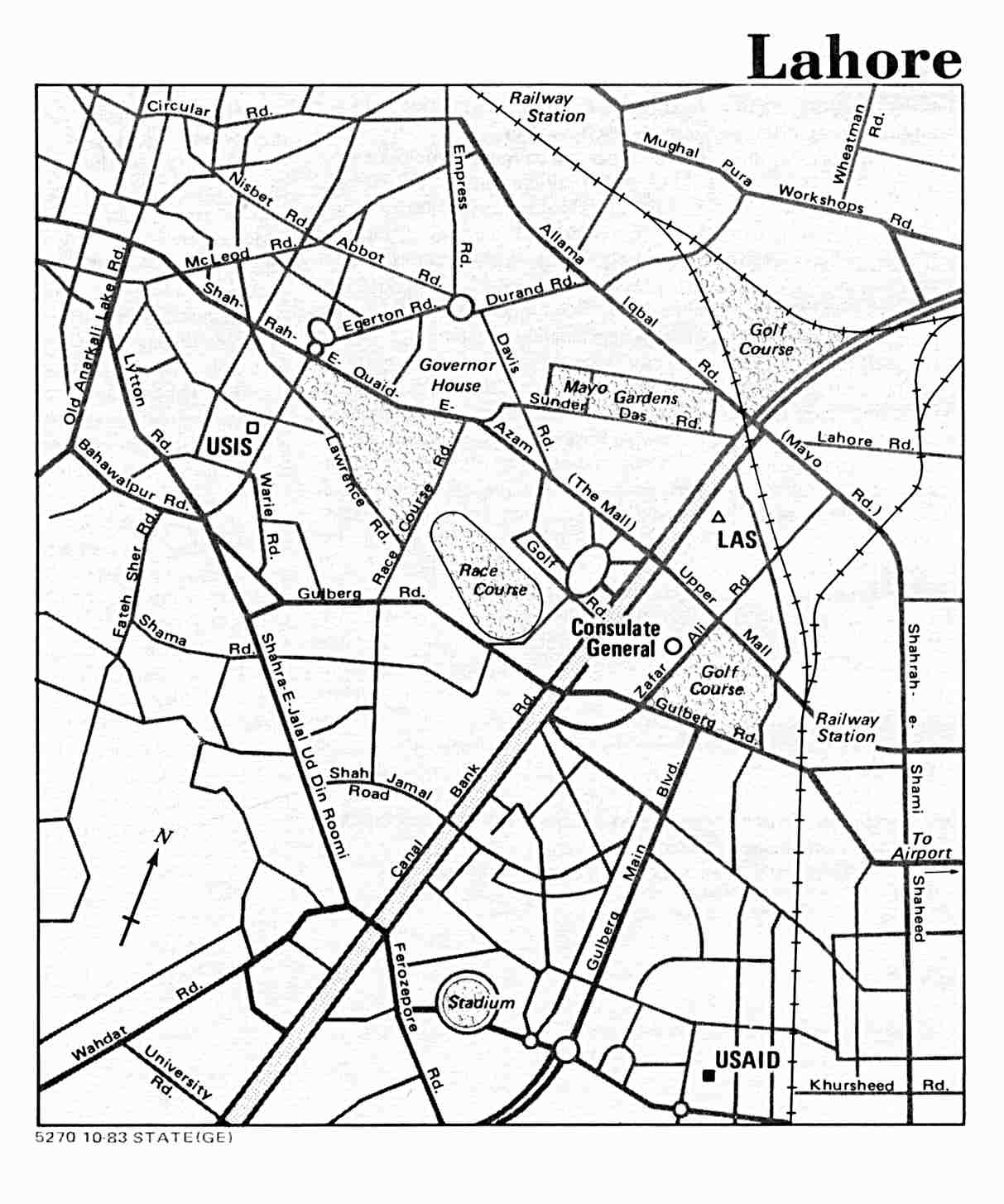HISTORY OF LAHORE

history of lahore
With a population of more than 7.5 million, Lahore is Pakistan's second largest city. It occupies a choice site in the midst of fertile alluvial plains. Ptolemy's "Geographia", written about AD I50, refers to it as "Labokla" and locates it with reference to the Indus, the Ravi, the Jhelum and the Chenab rivers
In the Deshwa Bhaga, previously mentioned, Lahore is called Lavpor, which at once points to its origin from Lav, the son of Rama, while in the ancient annals of Rajputana the name given is Loh Kot, meaning “the fort of Loh,” which, again, has reference to its mythical founder, Rama’s son. Turning to the Mahomedan period, the best authorities on the early Mahomedan conquests of India, are the historians of Scindh, for it was in that quarter that the first storm of those conquests under the Khalifat burst. Fatuhul Baldun, believed to be one of the earliest Arabic Chronicles, which gives an account of the first conquests of the Arabs in Syria, Mesopotamia, Egypt, Persia, Armenia, Transoxiana, Africa, Spain and Scindh, calls Lahore by the name of A’lahwur. The book, which is the work of Ahmad bin Yahya, surnamed Al-Biladuri, who lived at the Court of Baghdad towards the middle of ninth century of the Christian era, in the Khalifat of Al-m’tamid-Billah, is frequently cited by Ibn-I-Haukal, Almasudi and other ancient Arabic geographers. In times as early as the Khalifut of Umar, an expedition was sent under Hakam, son of Abul’asi, of the tribe of Sakif, to Baruz (Broach) and Debal. During the reign of Usman, Hakim, son of Jahalla-al’abdi, was sent to the confines of Hind ‘in order to acquire knowledge and bring back information.’ In the beginning of the year 39 A.H. (659 A.D.), during the Khalifat of Ali, son of Abu Talib, Haras, son of Marral ‘Abdi, proceeded. With the sanction of the Khalif, to the same frontier, as a volunteer. He reached Kekan in Scindh, was victorious and made captive, but was subsequently slain.In the year 44 A.H. (664 A.D.), and in the days of the Khalif Mu’awiya,” continues our author, “Mohallab, son of the Abu Safra, made war upon the same frontier, and advanced as far as Banna (Bannu) and Alahwar (Lahore) which lie between Multan and Cabul. The enemy opposed him and killed him and his followers.The great traveller Al-Idrisi, of Morocco, in his work the Nuzhatulmushtak-fi-Iftikharul Afak, writing in the ninth century, calls it Lohawar. The termination ‘Awar is a corruption of the Sanscrit word Awarna, meaning fort, and is affixed to many Indian towns, such as Sanawar, Bijawar, Peshawar. Lobawar would, thus, simply mean “fort of Loh,” and the name would establish its identity with the “Loh Kot” of the Hindu Puranas.Abu Rehan Al-Biruni, in his celebrated work, the Kanun, speaking from his personal knowledge of the country at the time of Mahmud’s invasion, towards the close of the tenth century, mentions, in his description of the Himalayan mountains, that “they can be seen from Tacas (Taxila?) and Lahawar (Lahore).” M. Reinaud, in his Fragments, and Elliot, read it as Lauhaour, Lohaovar, Loharu and Lahor. Amir Khusrow, of Delhi, writing in the latter part of the thirteenth century, calls it Lahanur in his well-known work the Kiranus-sa’den. He says:- “From the confines of Samania to Lahanur, There is no walled (city) but Kasur.”Mr. Thornton suggests that Lahanur is a corruption of Luhanagar, nur being the Dakhani form of nagar, as appears from the names of other towns, such as Kalanore, Kananore, ...etc.Rashid-ud-Din, in his Jamiut Tawarikh, completed in A.H. 710, or A.D. 1310, calls it Lahur, “than which,” he says, “there is no stronger fort.”Al Biruni also mentions Lahore as a Province, the capital of which was “Mandhukur” on the east of the river Irawa (Ravi). Baihanki calls it “Mandkakur”. Lahore is also called by the Mahomedan historians Lohar, Loher and Rahwar, the origin of the last name being explained by the fact of its situation on the great imperial roads to Cabul, Kashmir and Agra.
In whatever form it may have been written by the early Mahomedan writers, it is manifest from the above summary that the name, Lahore, has clear reference to its founder, and that founder was, in all probability, Loh, the son of Rama.
Badshahi Mosque, Lahore
The city next crops up in literature in connection with the campaigns of the Turkish dynast Mahmud of Ghazni against the Rajas of Lahore between I00I and I008. Around this time it established itself as the capital of the Punjab and thereafter began to play an important and growing role as a centre of Muslim power and influence in the subcontinent. Its heyday was the Mughal era from the early sixteenth century onwards and, as Mughal power began to decline in the eighteenth and nineteenth centuries, Lahore suffered a concomitant period of ignominy and political eclipse. It was here, at the beginning of the nineteenth century, that the Sikh ruler Ranjit Singh declared himself Maharajah of the Punjab and allowed his troops to desecrate many of the city's beautiful Islamic shrines- including the Badshahi Mosque which was, for a while, converted into a powder magazine. By the time British occupied Lahore in I849, one writer moved to describe the city as 'a mere expanse of crumbling ruins'.
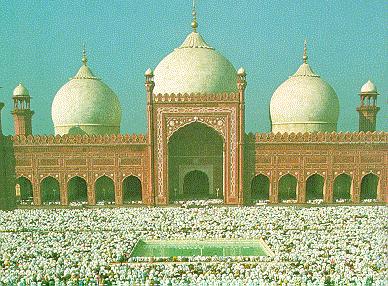
Minar-e-Pakistan, Lahore
Happily, this was an exaggeration and today the great buildings laid down by the long-vanished Mughal emperors may be seen in much of their original splendour. All the adverse influences since then seem to have been washed away, like sediment carried off by a flood, leaving behind the fundamental character and beauty of this old Islamic settlement. Fittingly, it was here in I940 that the Muslim League made its first formal demand for the establishment of a Muslim homeland. A towering and graceful monument, the Minar-e-Pakistan now stands on the site of the passing of the Pakistan Resolution.
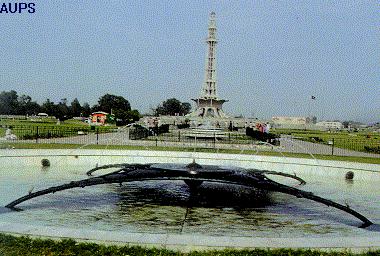
lahore Fort, Lahore
turning in an ink-blue firmamentNearby, the massively fortified walls of Lahore Fort speak eloquently of the centuries of passing history that they have witnessed. The fort antedates the coming of Mahmud of Ghazn i in the eleventh century, was ruined by the Mangols in I241, rebuilt in I267, destroyed a gain by Timurlane in I398 and rebuilt once more in I421. The great Mughal emperor Akbar re placed its mud walls with solid brick masonry in I566 and extended it northwards. Later Je hangir, Shah Jehan and Aurangzeb all added the stamps of their widely differing personalit ies to its fortification, gateways and palaces.
The fort encloses an area of approximately thirty acres and it is possible to spend many hours wandering there, lost in contemplation of times gone by, trying to reconstruct in your imagination a way of life that the world will never see again. The buildings within its walls are a testament to the gracious style of Mughal rule at its height, in which every man knew his place and courtly behaviour had been refined into an elaborately startified social code. Much of the architecture reflects this code. From a raised balcony in the Diwan-e-Aam, or Hall of Public Audience, built by Shah Jehan in I63I, the emperors looked down on the common people over whom they ruled when they came to present petitions and to request the settlement of disputes. Wealthier citizens and the nobility were allowed to meet their emperors on a level floor in the Diwan-e-Khas, the Hall of Special Audience-which was also built by Shah Jehan, in I633.

Shish Mahal, Lahore
While the Hall of Audience are characterized by their strict functionality, other buildings raised under Shah Jehan's patronage are styled in a more imaginative and fanciful mood. Of these the Shish Mahal, or Palace of Mirrors, which stands on the fort's north side, is by far the most splendid. It consists of a row of high domed rooms, the roofs of which are decked out with hundreds of thousands of tiny mirrors in the fashion of the traditional Punjabi craft of "Shishgari" (designs made from mirror fragments). A fire-brand lit inside any part of the Palace of Mirrors throw back a million reflections that dizzy the eye and seem like a galaxy of far-off stars .
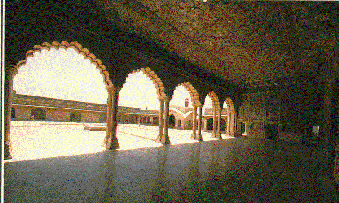
Shalimar Garden, Lahore
Another magnificent remnant of the Mughal era, also partially vandalized in the late eighteenth century by the invading Sikhs, is the Shalimar Garden which stands on the Grand Trunk Road about eight kilometers to the east of the old part of Lahore. "Shalimar" means 'House of Joy' and, in truth, the passing centuries have done nothing to detract from the indefinable atmosphere of light-heartedness and laughter that characterizes this green and peaceful walled retreat. A canal runs the entire 2,006 foot (6II meters) length of the garden and from it 450 sparkling fountains throw up a skein of fresh water that cools and refreshes the atmosphere, making this a favourite place for afternoon walks for the citizens of modern Lahore.
Lahore is rightly regarded as the cultural, architectural and artistic center of Pakistan; indeed, the city is so steeped in historical distinction that it would be possible to spend a lifetime studying it without learning everything that there is to learn.
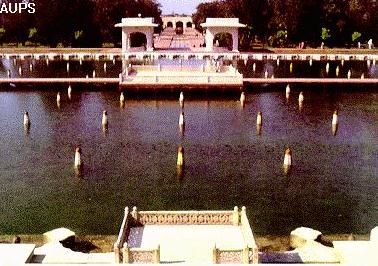

![]()
history of lahore
With a population of more than 7.5 million, Lahore is Pakistan's second largest city. It occupies a choice site in the midst of fertile alluvial plains. Ptolemy's "Geographia", written about AD I50, refers to it as "Labokla" and locates it with reference to the Indus, the Ravi, the Jhelum and the Chenab rivers
In the Deshwa Bhaga, previously mentioned, Lahore is called Lavpor, which at once points to its origin from Lav, the son of Rama, while in the ancient annals of Rajputana the name given is Loh Kot, meaning “the fort of Loh,” which, again, has reference to its mythical founder, Rama’s son. Turning to the Mahomedan period, the best authorities on the early Mahomedan conquests of India, are the historians of Scindh, for it was in that quarter that the first storm of those conquests under the Khalifat burst. Fatuhul Baldun, believed to be one of the earliest Arabic Chronicles, which gives an account of the first conquests of the Arabs in Syria, Mesopotamia, Egypt, Persia, Armenia, Transoxiana, Africa, Spain and Scindh, calls Lahore by the name of A’lahwur. The book, which is the work of Ahmad bin Yahya, surnamed Al-Biladuri, who lived at the Court of Baghdad towards the middle of ninth century of the Christian era, in the Khalifat of Al-m’tamid-Billah, is frequently cited by Ibn-I-Haukal, Almasudi and other ancient Arabic geographers. In times as early as the Khalifut of Umar, an expedition was sent under Hakam, son of Abul’asi, of the tribe of Sakif, to Baruz (Broach) and Debal. During the reign of Usman, Hakim, son of Jahalla-al’abdi, was sent to the confines of Hind ‘in order to acquire knowledge and bring back information.’ In the beginning of the year 39 A.H. (659 A.D.), during the Khalifat of Ali, son of Abu Talib, Haras, son of Marral ‘Abdi, proceeded. With the sanction of the Khalif, to the same frontier, as a volunteer. He reached Kekan in Scindh, was victorious and made captive, but was subsequently slain.In the year 44 A.H. (664 A.D.), and in the days of the Khalif Mu’awiya,” continues our author, “Mohallab, son of the Abu Safra, made war upon the same frontier, and advanced as far as Banna (Bannu) and Alahwar (Lahore) which lie between Multan and Cabul. The enemy opposed him and killed him and his followers.The great traveller Al-Idrisi, of Morocco, in his work the Nuzhatulmushtak-fi-Iftikharul Afak, writing in the ninth century, calls it Lohawar. The termination ‘Awar is a corruption of the Sanscrit word Awarna, meaning fort, and is affixed to many Indian towns, such as Sanawar, Bijawar, Peshawar. Lobawar would, thus, simply mean “fort of Loh,” and the name would establish its identity with the “Loh Kot” of the Hindu Puranas.Abu Rehan Al-Biruni, in his celebrated work, the Kanun, speaking from his personal knowledge of the country at the time of Mahmud’s invasion, towards the close of the tenth century, mentions, in his description of the Himalayan mountains, that “they can be seen from Tacas (Taxila?) and Lahawar (Lahore).” M. Reinaud, in his Fragments, and Elliot, read it as Lauhaour, Lohaovar, Loharu and Lahor. Amir Khusrow, of Delhi, writing in the latter part of the thirteenth century, calls it Lahanur in his well-known work the Kiranus-sa’den. He says:- “From the confines of Samania to Lahanur, There is no walled (city) but Kasur.”Mr. Thornton suggests that Lahanur is a corruption of Luhanagar, nur being the Dakhani form of nagar, as appears from the names of other towns, such as Kalanore, Kananore, ...etc.Rashid-ud-Din, in his Jamiut Tawarikh, completed in A.H. 710, or A.D. 1310, calls it Lahur, “than which,” he says, “there is no stronger fort.”Al Biruni also mentions Lahore as a Province, the capital of which was “Mandhukur” on the east of the river Irawa (Ravi). Baihanki calls it “Mandkakur”. Lahore is also called by the Mahomedan historians Lohar, Loher and Rahwar, the origin of the last name being explained by the fact of its situation on the great imperial roads to Cabul, Kashmir and Agra.
In whatever form it may have been written by the early Mahomedan writers, it is manifest from the above summary that the name, Lahore, has clear reference to its founder, and that founder was, in all probability, Loh, the son of Rama.
Badshahi Mosque, Lahore

Minar-e-Pakistan, Lahore

lahore Fort, Lahore
The fort encloses an area of approximately thirty acres and it is possible to spend many hours wandering there, lost in contemplation of times gone by, trying to reconstruct in your imagination a way of life that the world will never see again. The buildings within its walls are a testament to the gracious style of Mughal rule at its height, in which every man knew his place and courtly behaviour had been refined into an elaborately startified social code. Much of the architecture reflects this code. From a raised balcony in the Diwan-e-Aam, or Hall of Public Audience, built by Shah Jehan in I63I, the emperors looked down on the common people over whom they ruled when they came to present petitions and to request the settlement of disputes. Wealthier citizens and the nobility were allowed to meet their emperors on a level floor in the Diwan-e-Khas, the Hall of Special Audience-which was also built by Shah Jehan, in I633.

Shish Mahal, Lahore

Shalimar Garden, Lahore
Lahore is rightly regarded as the cultural, architectural and artistic center of Pakistan; indeed, the city is so steeped in historical distinction that it would be possible to spend a lifetime studying it without learning everything that there is to learn.

